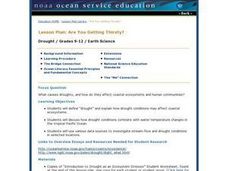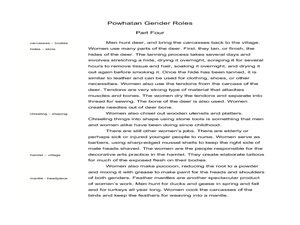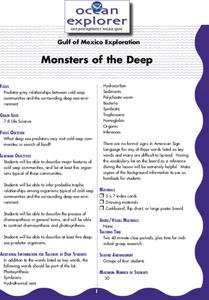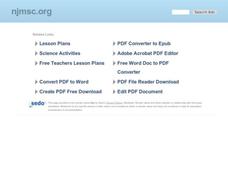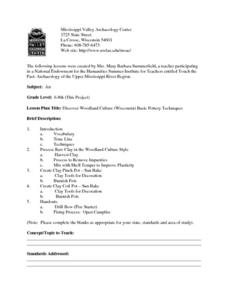Curated OER
Name That Food: ESL Activity
In this naming food worksheet, students complete 10 multiple choice questions, selecting the correct food group for 10 different foods. Worksheet is part of an ESL site.
Curated OER
Homonyms - Quiz 1
Learners take a quiz on homonyms. For this homonyms lesson plan, students take a multiply choice quiz on words that sound alike but that are spelled and mean different things.
Curated OER
Homonyms - Quiz 3
In this homonyms worksheet, students fill in the blanks to sentences with the correct homonym. Students complete 20 multiple choice questions.
Curated OER
Homonyms - Quiz 36
In this homonyms activity, students fill in the blanks to sentences with the correct homonym. Students fill in the blanks for 20 sentences.
Curated OER
Are You Getting Thirsty?
Students study droughts and how they affect communities and coastal ecosystems. In this ecosystems lesson students use data to examine drought conditions in certain areas.
Curated OER
Powhatan Gender Roles
In this Powhatan gender roles worksheet, high schoolers read a 4-page selection regarding the gender roles in Powhatan culture. Students discuss the selection.
Curated OER
ESL Food Activity
In this ESL food activity students match pictures of food items to their names, read a set of labeled items, then label food items from memory. A link to audio and HTML is given.
Curated OER
Commonly Confused Words - Quiz 1
In this confused words worksheet, students fill in the blanks to sentences by choosing the correct confusing word. Students complete 19 sentences.
Curated OER
Monsters of the Deep
Learners describe major features of cold seep communities, and list at least five organisms typical of these communities. They infer probable trophic relationships among organisms typical of cold-seep communities.
Curated OER
Bivalve or Univalve (Clam or Snail)?
Fourth graders explore the meaning of the prefixes "bi" and "uni." In groups, 4th graders observe pictures of shells and handle real shells. Students create a chart to classify each shell as a bivalve or univalve. They identify the...
Curated OER
Bivalve Biology
Young scholars place clams into a beaker containing saltwater. They place a small drop of food coloring just above the shell. Students observe the movement of the food coloring. Clams are then placed into clean beakers of saltwater with...
Curated OER
Mollusk of Interest
Student choose a mollusk that they are interested in and research it. They present their research to the class and compile all the information on mollusks in a packet. Information must include common and scientific name, family,...
Curated OER
Create a Display
Young scholars identify mollusks, create a display, research a particular species, and present their findings to the class. They collect and bring in a shell of choice from their local beach. Then, students label his or her shell with...
Curated OER
Sunflower Stars
In this sunflower star worksheet, students read about sunflower stars. They then use what they learned and answer the 18 questions on the page. They need to use a dictionary for one of the sections. The answers are on the last pages.
Curated OER
Life is Weird
Students study the organisms that are found in cold seeps and see how they interact with each-other. In this biological organism instructional activity students describe the major features of cold seeps and the process of...
Curated OER
Life is Weird
Students describe features of cold seep communities and list organisms that can be found in these communities. For this exploratory lesson students complete an activity and describe the process of chemosynthesis.
Curated OER
Intertidal Field Trip
Students explore an intertidal zone. In this science lesson plan, students travel to an intertidal zone. Students collect data and create species accumulation curves.
Curated OER
Germany Rejects Spanish ‘Transfer Bid’ for Octopus
Tenth graders explore the importance of Paul the octopus. For this World Cup lesson, 10th graders research the location of Germany and its cities on a map. Students read an article and answer questions.
Curated OER
Measuring Aquatic pH
Students apply the scientific method and safety rules to aquatic pH. They test unknown solutions for pH levels.
Curated OER
Black Pearls
Students examine where pearls come from and where mollusks are found. They discover how pearls are formed in nature and how they are they made by humans. They use ordinary oyster shells to examine mother of pearl.
Curated OER
Having Tea Among The Stars
Students study the struggles and achievements of women in the field of astronomy. They create comparisons of the lives of these women through research. They write a vignette with their group that describes these women sitting down to tea...
Curated OER
Relating Number of Insect Species to Water Quality
Students are asked to respond to questions such as:" Have there been surveys of the area to inventory the species?" (For example, for a wetland area, do they know what amphibians live there and how abundant they are?) Are there any...
Curated OER
Discover Woodland Culture: Wisconsin Basic Pottery Techniques
Students take a field trip to a local woodland to find pieces of clay. Once they are back in the classroom, they dry the clay throughly and turn it in to clay slip. They watch a PowerPoint presentation on basic art terms and create...
Other popular searches
- Zebra Mussels
- Zebras Mussels
- Dominant Traits Mussels
- Mussels and Stael
- Freshwater Mussels
- Zebras+mussels
- "Zebra Mussels
- Environment Zebra Mussels
- Environment, Zebra Mussels
- Bones & Mussels




